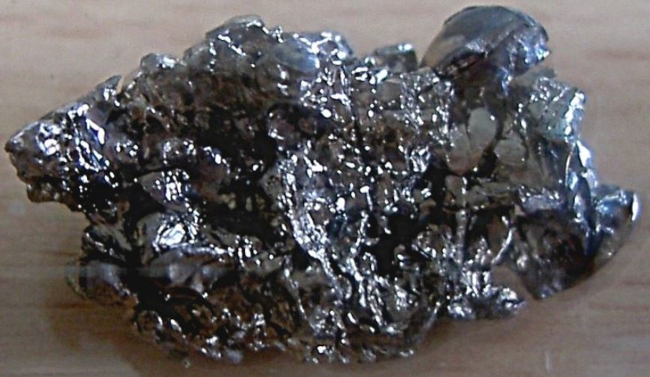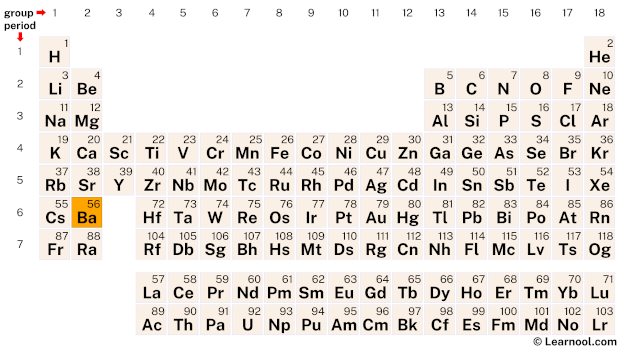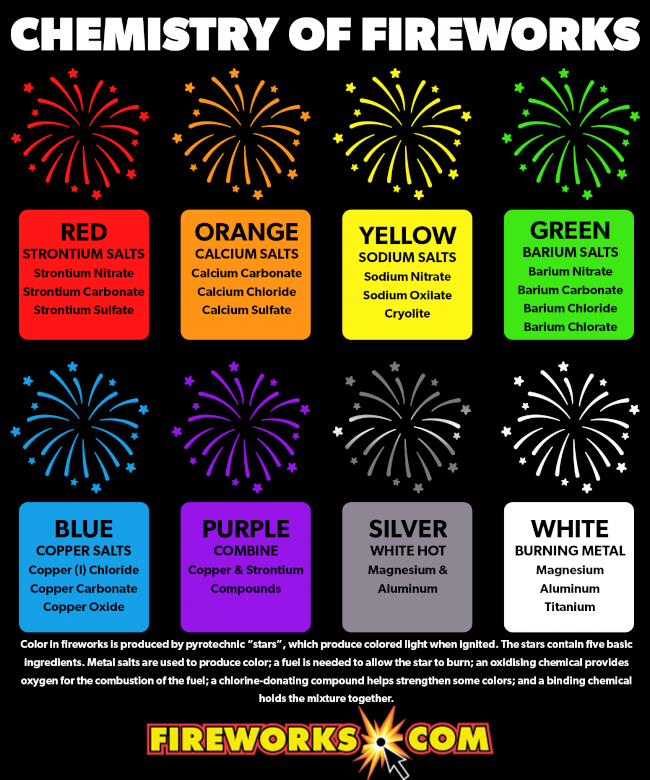
Barium (Ba) is a chemical element of the periodic table, located in the group 2 and the period 6, and has the atomic number 56. It is a soft, silvery-white alkaline earth metal, whose name comes from the Greek word “barys”, which means heavy. It is a highly reactive metal that is not available freely in nature.
On periodic table
| group | ⇨ | 1 | 2 | 3 | 4 | 5 | 6 | 7 | 8 | 9 | 10 | 11 | 12 | 13 | 14 | 15 | 16 | 17 | 18 |
| period | ⇩ | ||||||||||||||||||
| 1 | 1 H  Hydrogen |
2 He  Helium |
|||||||||||||||||
| 2 | 3 Li  Lithium |
4 Be  Beryllium |
5 B  Boron |
6 C  Carbon |
7 N  Nitrogen |
8 O  Oxygen |
9 F  Fluorine |
10 Ne  Neon |
|||||||||||
| 3 | 11 Na  Sodium |
12 Mg  Magnesium |
13 Al  Aluminium |
14 Si Silicon |
15 P  Phosphorus |
16 S  Sulfur |
17 Cl  Chlorine |
18 Ar  Argon |
|||||||||||
| 4 | 19 K  Potassium |
20 Ca  Calcium |
21 Sc  Scandium |
22 Ti  Titanium |
23 V  Vanadium |
24 Cr  Chromium |
25 Mn  Manganese |
26 Fe  Iron |
27 Co  Cobalt |
28 Ni  Nickel |
29 Cu  Copper |
30 Zn  Zinc |
31 Ga  Gallium |
32 Ge  Germanium |
33 As  Arsenic |
34 Se  Selenium |
35 Br  Bromine |
36 Kr  Krypton |
|
| 5 | 37 Rb  Rubidium |
38 Sr  Strontium |
39 Y  Yttrium |
40 Zr  Zirconium |
41 Nb  Niobium |
42 Mo  Molybdenum |
43 Tc  Technetium |
44 Ru  Ruthenium |
45 Rh  Rhodium |
46 Pd  Palladium |
47 Ag  Silver |
48 Cd  Cadmium |
49 In  Indium |
50 Sn  Tin |
51 Sb  Antimony |
52 Te  Tellurium |
53 I  Iodine |
54 Xe  Xenon |
|
| 6 | 55 Cs  Caesium |
56 Ba Barium |
72 Hf  Hafnium |
73 Ta  Tantalum |
74 W  Tungsten |
75 Re  Rhenium |
76 Os  Osmium |
77 Ir  Iridium |
78 Pt  Platinum |
79 Au  Gold |
80 Hg  Mercury |
81 Tl  Thallium |
82 Pb  Lead |
83 Bi  Bismuth |
84 Po  Polonium |
85 At  Astatine |
86 Rn  Radon |
||
| 7 | 87 Fr  Francium |
88 Ra  Radium |
104 Rf  Rutherfordium |
105 Db  Dubnium |
106 Sg  Seaborgium |
107 Bh  Bohrium |
108 Hs  Hassium |
109 Mt  Meitnerium |
110 Ds  Darmstadtium |
111 Rg  Roentgenium |
112 Cn  Copernicium |
113 Nh  Nihonium |
114 Fl  Flerovium |
115 Mc  Moscovium |
116 Lv  Livermorium |
117 Ts  Tennessine |
118 Og  Oganesson |
||
| 57 La  Lanthanum |
58 Ce  Cerium |
59 Pr  Praseodymium |
60 Nd  Neodymium |
61 Pm  Promethium |
62 Sm  Samarium |
63 Eu  Europium |
64 Gd  Gadolinium |
65 Tb  Terbium |
66 Dy  Dysprosium |
67 Ho  Holmium |
68 Er  Erbium |
69 Tm  Thulium |
70 Yb  Ytterbium |
71 Lu  Lutetium |
|||||
| 89 Ac  Actinium |
90 Th  Thorium |
91 Pa  Protactinium |
92 U  Uranium |
93 Np  Neptunium |
94 Pu  Plutonium |
95 Am  Americium |
96 Cm  Curium |
97 Bk  Berkelium |
98 Cf  Californium |
99 Es  Einsteinium |
100 Fm  Fermium |
101 Md  Mendelevium |
102 No  Nobelium |
103 Lr  Lawrencium |
|||||
| – s block |
Barium is an s-block element, situated in the second column and the sixth row of the periodic table, denoted by the atomic number 56 and chemical symbol Ba.
Element information
 |
|
 |
|
| Origin of name | Greek word “barys” (which means heavy) |
| Symbol | Ba |
| Atomic number (Z) | 56 |
| Atomic mass | 137.327 u |
| Block | s-block |
| Group | 1 |
| Period | 6 |
| Classification | Alkaline earth metal |
| Atomic radius | 222 pm |
| Covalent radius | 215±11 pm |
| Van der Waals radius | 268 pm |
| Melting point | 727 ℃, 1341 ℉, 1000 K |
| Boiling point | 1845 ℃, 3353 ℉, 2118 K |
| Electron configuration | [Xe] 6s2 |
| Learn how to write: Barium electron configuration | |
| Electrons per shell | 2, 8, 18, 18, 8, 2 |
| Learn how to draw: Barium Bohr model | |
| Crystal structure | Body-centered cubic (bcc) |
| Phase at r.t | Solid |
| Density near r.t | 3.51 g/cm3 |
| Main isotopes | Barium-132, Barium-134, Barium-135, Barium-136, Barium-137, Barium-138 |
| Natural occurrence | Primordial |
| Oxidation state | +2 |
| Electronegativity (Pauling scale) | 0.89 |
| Protons Neutrons Electrons |
56 81 56 |
| Learn how to find: Barium protons neutrons electrons | |
| Valence electrons | 2 |
| Learn how to find: Barium valence electrons | |
| CAS number | 7440-39-3 |
| Discovered by | Carl Wilhelm Scheele in 1774 |
History

Barium has been known since ancient times due to its occurrence in mineral deposits, but its discovery as a distinct element dates back to the late 18th century. In 1774, Carl Wilhelm Scheele, a Swedish chemist, identified barium oxide and noted its similarity to lime. However, he did not realize that the two substances were different elements.
In 1808, Sir Humphry Davy, an English chemist, conducted electrolysis experiments on molten barium salts and succeeded in isolating pure barium metal. He named the new element barium, after the Greek word “barys,” meaning heavy, due to its high atomic weight.
In the early 19th century, barium compounds were used in the textile industry to manufacture black and green dyes. They were also used in medicine as a laxative and as a contrast agent in X-ray imaging. The bright green color of barium compounds made them popular for use in fireworks, and this application continues today.
During the 20th century, barium continued to be used in medicine, especially in diagnostic imaging techniques such as barium enemas and barium meals. Barium was also used in the manufacture of vacuum tubes for electronic equipment, and as a deoxidizer in the production of aluminum alloys. Today, barium is still used in a variety of applications, including in the production of ceramic and glass materials, in the petroleum industry, and in the production of rubber products.
Occurrence and production
Barium is a relatively abundant element on Earth, with an estimated concentration of 425 ppm in the Earth’s crust. It occurs naturally in the minerals barite (BaSO4) and witherite (BaCO3), and can also be found in some mineral springs. The majority of commercial production of barium compounds involves the extraction of barite, which is typically done through mining. The largest commercial producers of barite are China, India, and Morocco. The extracted ore is then crushed and ground to produce a fine powder, which is then subjected to a series of chemical treatments to purify and concentrate the barium.
The primary method for producing metallic barium involves the reduction of barium oxide (BaO) with aluminum metal at high temperatures. This produces barium vapor, which is condensed into a solid form. Another method for producing barium involves the electrolysis of molten barium chloride (BaCl2) using a mercury cathode. This produces elemental barium and chlorine gas as byproducts. However, this method is less commonly used due to the high cost of production and safety concerns associated with handling mercury.
Properties
Barium is a soft, silvery-white metal that oxidizes quickly in air.
It has a melting point of 727 ℃ and a boiling point of 1845 ℃.
Barium is a highly reactive metal that can react with water or other chemicals to produce potentially hazardous gases, such as hydrogen gas or ammonia gas.
It is a good conductor of electricity and has a relatively low density.
Barium is an alkaline earth metal, which means it has similar properties to other elements in this group, such as calcium and magnesium.
It can form a variety of chemical compounds, including barium sulfate (BaSO4), barium chloride (BaCl2), and barium nitrate [Ba(NO3)2].
Applications
Medicine
Barium sulfate is used as a contrast medium in medical imaging procedures such as X-rays and CT scans. It helps to highlight the digestive tract and gastrointestinal system to aid in diagnosis.
Fireworks

Barium is commonly used in pyrotechnics to produce bright green colors in fireworks. This is due to the emission of green light when barium compounds are heated.
Petroleum industry
Barium is used in the petroleum industry to increase the density of drilling mud. Barium sulfate is added to the mud to help control pressure and prevent blowouts during drilling.
Electronics
Barium titanate is a ceramic material that exhibits ferroelectric properties and is used in the manufacture of capacitors, varistors, and other electronic components.
Glass industry
Barium is used in the glass industry to improve the refractive index and durability of glass. Barium oxide is added to the glass mixture to enhance its chemical and thermal resistance.
Agriculture
Barium is an essential micronutrient for some plants, and deficiency can lead to stunted growth and poor yields. Barium sulfate is also used in animal feed as a filler and source of dietary sulfate.
Interesting facts
Barium has a unique property of being able to absorb X-rays, which makes it useful in medical imaging such as X-ray and CT scans.
The name barium comes from the Greek word “barys” which means heavy.
Barium is a highly reactive element and must be stored in oil or kerosene to prevent it from reacting with air or water.
Barium is used in the production of various types of glass, including cathode ray tubes, which are used in televisions and computer monitors.
When burned, barium emits a bright green light, which is why it is used in fireworks and flares.
Barium compounds are used in the petroleum industry to increase the density of drilling fluids, which helps to prevent blowouts.
Barium sulfate is often used as a contrast agent in medical tests such as barium swallows and barium enemas.
Barium carbonate has been used for centuries as a rat poison, although it is now largely prohibited due to its toxicity.
Related
More elements
External links
- https://www.rsc.org/periodic-table/element/56/barium
- https://en.wikipedia.org/wiki/Barium
- https://www.britannica.com/science/barium
- https://pubchem.ncbi.nlm.nih.gov/element/Barium
- https://www.chemicool.com/elements/barium.html
- https://chemistrytalk.org/barium-element/
- https://www.livescience.com/37581-barium.html
Deep
Learnool.com was founded by Deep Rana, who is a mechanical engineer by profession and a blogger by passion. He has a good conceptual knowledge on different educational topics and he provides the same on this website. He loves to learn something new everyday and believes that the best utilization of free time is developing a new skill.
